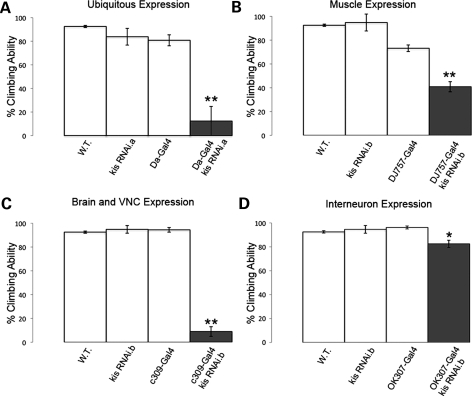Figure 2.
Kismet knockdown in muscles causes defective climbing behavior. (A–D) shows compiled climbing ability of wild-type, control and Kis knockdown flies at days 2–10. (A) Ubiquitous expression of UAS:Kis RNAi.a (Da-Gal4/UAS:Kis RNAi.a) shows severely reduced climbing ability compared with wild-type, Da-Gal4/+ and UAS:Kis RNAi.a/+ outcrossed control flies. (B) Kis knockdown restricted to muscles (DJ757-Gal4/UAS:Kis RNAi.b) also shows a strong reduction in climbing ability compared with wild-type, DJ757-Gal4/+ and UAS:Kis RNAi.b/+ outcrossed controls. (C) Kis knockdown in mushroom body neurons and the ventral nerve cord (c309-Gal4/UAS:Kis RNAi.b) shows a strong reduction in climbing ability compared to wild-type, c309-Gal4/+ and UAS:Kis RNAi.b/+ outcrossed controls. (D) Kis knockdown in the giant fiber inter-neurons (OK307-Gal4/UAS:Kis RNAi.b) shows a small but significant effect compared with wild-type, OK307-Gal4/+ and UAS:Kis RNAi.b/+ outcrossed controls. Error bars represent ± SEM. In all cases, double asterisk indicates P < 0.001 and asterisk indicates P < 0.05 compared with controls.

